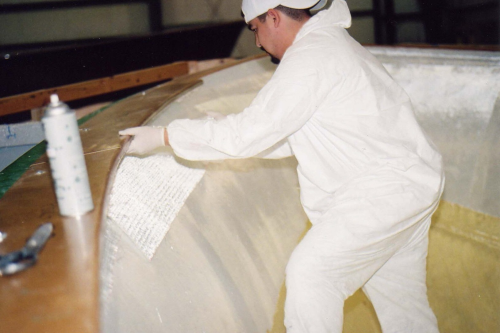
Westech Aerosol Corporation's Infuzene adhesive was developed to hold dry materials onto structural surfaces (including vertical and tight radius work) during the vacuum infusion process.
Infuzene is a high strength, high temperature, solvent-based adhesive designed to safely fuse laminating materials to structural core surfaces, forming a continuous matrix without structural weakness. Since it will not interfere with the curing process of vinyl esters, polyester or styrene resins, it allows resins to obtain maximum tensile shear strength. The adhesive crosslinks and hardens along with the ester or styrene resins to form an integrated structure.
According to Westech Aerosol, recent tests conducted by a leading independent university composites testing lab, indicated the Infuzene adhesive provided a stronger bond in the vacuum infusion process than the leading general-purpose spray adhesive. Based on ASTM 2344 short beam shear strength testing standards, the results indicate that the composite with Infuzene was up to 30% stronger in interlaminar shear strength than the same composite with the leading alternative.
In the tests, seven plates were tested to failure under three point bending. The MPa difference was +4.3 for light coverage at 12.5 g/m2 and +7.0 for double coverage at 25 g/m2. The MPa % difference was +18.53% for light coverage and +30.17% for double coverage. In related tests, control specimens without adhesive failed at an average of 50.2 MPa, while specimens with the Westech Infuzene adhesive failed at an average of 48.2 MPa at 12.5 g/m2, equal to 96% of the control specimens.
In a separate osmotic test by CRITT Materiaux Poitou-Charentes, a leading French testing firm, the Westech adhesive was tested alongside an adhesive product already in use in the yacht building industry. The tests determined that Westech Infuzene showed a superior resistance to osmotic ageing compared to the reference product, which started blistering after only 5 days of exposure to a laminar flow of water. The vacuum infusion-specific adhesive is primarily used for glass fibre composites but its crosslinking properties with resin also provide greater interlaminar shear strength for carbon fibre and Kevlar materials. A canister system with a reusable gun and hose eliminates the need for air-assisted application systems and allows continuous application for large projects when a 13-ounce can is insufficient.
General-purpose adhesives and vacuum infusion
The vacuum infusion process is used to create lightweight composite components for boat hulls and wind turbine blades, high performance race car bodies, aviation parts and automobile parts.
In the process, adhesive is used to temporarily hold dry materials laid into a mould until they’re enclosed in a vacuum bag and resin is injected. This is especially important on vertical or tight radius work, where dry materials are prone to slip or move.
However, according to Westech Aerosol, when general-purpose spray adhesive is used to hold the layers of dry material together during the infusion process, it may act as a contaminant that can ultimately compromise the structural integrity of the part and lead to premature failure in the field.
The general-purpose spray adhesives many companies use can interfere with the resin curing process. They can even inhibit resin flow if applied too thickly or unevenly, causing the resin to part around that area like a rock in a stream of water. When this occurs, air pockets, bubbles of resin, or osmotic blisters can form within the structure of the composite, making delamination or structural failure more likely.
Osmotic blistering, a form of composite failure that is a particular problem in marine applications, occurs when water penetrates and encounters a pocket of uncured resin. This results in a blister of acidic fluid under pressure that will eventually break through to the surface. Repair of the blisters requires grinding out the blisters, thoroughly drying the hull, and patching the craters.






